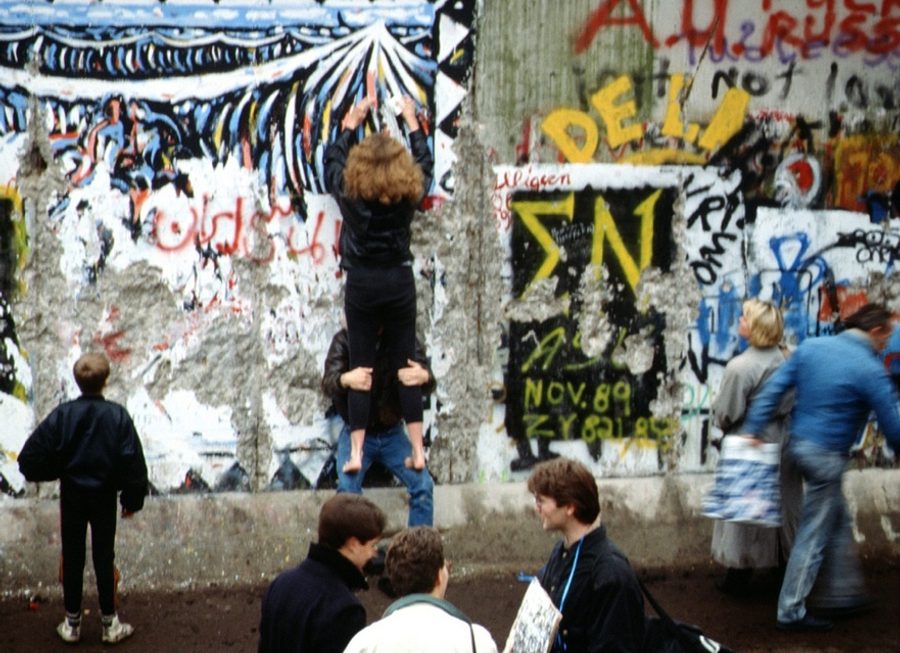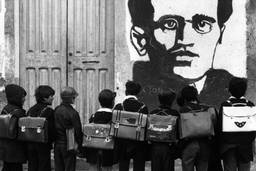Reagan and Gorbachev Didn’t Tear Down the Berlin Wall
Don’t be fooled by the mainstream narrative: The 1989 revolutions weren’t just byproducts of extraordinary historical circumstances. Change happens when activists seize a moment and escalate.
Mark Engler and Paul Engler

On November 9, 1989, huge crowds of East Germans descended on the Berlin Wall. The restless citizens were responding to an announcement by authorities suggesting that the government would loosen travel restrictions. In truth, those in charge intended to make only limited alterations in visa requirements. But these intentions quickly became irrelevant. Mass numbers of people flocked to the wall, overwhelming the border guards. Soon, along with allies from the West, the crowds began dismantling the hated barrier for good.
Remarkably, although the fall of the Berlin Wall was an iconic moment, it was just one of the highlights in a flurry of activity that was sweeping through the Soviet Bloc—a series of uprisings that would become known as the revolutions of 1989.
Every so often, we witness a period of mass insurgency that seems to defy the accepted rules of politics: Protests seem to begin popping up everywhere. Organizers see their rallies packed with newcomers who come from far outside their regular network of supporters. Mainstream analysts, taken by surprise, struggle for words. And those in power scramble as the political landscape around them dramatically shifts—sometimes leaving once-entrenched leaders in perilous positions.
If ever there was a time in modern history that exemplified such a moment of peak public activity, it was the second half of 1989.
Although the crowds at the Berlin Wall on November 9 assembled in impromptu fashion, their gathering was not altogether spontaneous. It came after months of growing demonstrations and escalating pressure on the country's Communist Party. Throughout the fall, weekly rallies in Leipzig called for freedom of travel and democratic elections. Demonstrations in that city began with just a few hundred protesters, but they grew exponentially until, by early November, they were attracting as many as a half million people. The contagion reached other cities as well: Mass protests started erupting in Dresden, East Berlin and beyond.
Demonstrations in East Germany did not feed only off each other; they also drew energy from what had become a region-wide revolt. Earlier that year, in the spring, historic marches in Hungary set an example of how popular pressure could propel forward negotiations with a reformist government. That summer, in Poland, the union-based opposition party Solidarity—having led a series of crippling strikes the year before—won a stunning and decisive victory in the country's newly liberalized elections. By autumn, rebellion was in full bloom. Hardly more than a week after the November 9 revolt in East Germany, students in Prague undertook the first demonstration of the “Velvet Revolution.” By the end of the month, social movements would call a general strike and force the end of one-party rule in Czechoslovakia.
Looking back now, what can we learn from these extraordinary mobilizations?
Conventional political analysts see the revolutions of 1989 as a spontaneous, once-in-a-lifetime swelling of popular discontent. Their description of the wave of uprisings in Eastern Europe mirrors the assertions they make virtually every time an outbreak of mass mobilization erupts on the political stage: They tell us that these moments of peak activity are rare and unpredictable. They contend that mass protest is the product of broad historical forces. And they suggest that no one could consciously engineer events that trigger such upheavals.
On each of these points, the political tradition known as “civil resistance” offers a contrary interpretation. Those who listen will take very different lessons from the momentous ferment of 25 years ago.
Civil resistance—the study and practice of nonviolent conflict—is a tradition that traces its lineage through the campaigns of Gandhi, the U.S. civil rights movement, the works of scholars such as Gene Sharp, and contemporary revolts such as the Arab Spring. Immersed in the study of how unarmed uprisings work, analysts in this tradition put forth several propositions that challenge conventional wisdom about 1989: They contend, first, that extraordinary mobilizations are not as rare as they might seem; second, that there is an art to organizing around them; and third, that activists willing to embrace a strategy of nonviolent escalation can often set off historic upheavals of their own.
Uprisings large and small
Prior to the dismantling of the Berlin Wall, the idea that the Iron Curtain would fall not primarily through coups and military maneuvers, but through the mobilization of mass, unarmed resistance would have seemed improbable at best and quite possibly deluded. But what has been remarkable in recent decades is how frequently new examples of successful civil resistance have presented themselves. From the Philippines, to Chile, to South Africa, to Serbia, to Tunisia and Egypt, and beyond, the repertoire of civil resistance has ushered in remarkable changes.
Certainly, the revolutions of 1989 were exceptional in their breadth and impact. Yet, viewed in another way, mass uprisings are a more regular part of our political lives than we often acknowledge. Once you are looking for them, popular mobilizations start to appear constantly—materializing with little notice in diverse countries, drawing new participants out of the woodwork, and upending politics as usual. The Arab Spring of 2011 is an obvious example, one which evoked memories of Eastern Europe. But momentous disruptions need not be so sweeping and international to be significant. Nor need they take place in undemocratic contexts.
Just in the United States, and just in the past 15 years, we have seen disruptive outbreaks emerge with shocking frequency, capturing the spotlight at a wide range of levels, from the national to the local. Nationwide, landmark protests against the World Trade Organization and the International Monetary Fund in Seattle and Washington, D.C., at the turn of the century were followed by massive anti-war mobilizations in New York and San Francisco in 2003. Historic immigration marches that materialized in 2006 were followed by the multiplying encampments of the Occupy movement in 2011. State-level mobilizations such as the Wisconsin uprising, citywide protests against police brutality in Oakland and Ferguson, and campus living wage sit-ins, while taking place on more modest scales, have all had outsized impact in galvanizing public debate. For intensive spurts, each drew in unusual numbers of participants, activating people in ways that are mysterious and foreign to conventional politics.
That mainstream commentators are taken by surprise, again and again, by such mobilizations—large and small—speaks more to their own biases than to the contours of how social change happens.
And yet their biases are not unique. A predisposition toward gradualism extends even into social movement circles. The school of community organizing pioneered by Saul Alinsky has traditionally viewed mass mobilizations with suspicion. Organizers in this lineage charge that outbreaks of protest are flashes in the pan, too unpredictable and unsustainable to be relied upon. They stress that their goal is to build “organizations” not “movements”; they seek to create institutions that can leverage grassroots power on an ongoing basis. Interestingly, Alinsky himself was more open to extraordinary potential of peak moments than many of his ideological descendents. Seeing the rush of civil rights activity that followed the 1961 Freedom Rides in the segregated South, Alinsky and his protégé Nicholas von Hoffman dubbed it a “moment of the whirlwind.” The two agreed on the need to temporarily set aside their normal organizing methodologies in order to tap into the energy of the extraordinary uprising.
The politics of the unusual
In contrast to conventional politicians, and even to many organizers, Mohandas Gandhi and Martin Luther King carefully studied the dynamics of creating moments of the whirlwind. They were specialists in the politics of the unusual. Through the use of nonviolent conflict, they sought to produce ruptures in the normal functioning of the political system, and thus to propel previously ignored injustices to the fore of public consciousness. It was their talent for doing so that secured their places in history.
In his famous 1963 letter from the Birmingham city jail, King explained that the purpose of direct action “is to create a situation so crisis-packed that it will inevitably open the door to negotiation” with otherwise intransigent adversaries. Early in his career, King had been reluctantly thrown into crises created by other activists and organizations. But by the time of the Birmingham campaign, he had developed a savvy understanding of how to manufacture nonviolent conflicts that could stir national indignation and move foot-dragging politicians.
In his 1968 book, Where Do We Go From Here: Chaos or Community?, he described civil rights organizations using militant direct action as “specialists in agitation and dramatic projects,” creating “explosive events” that “attracted massive sympathy and support.” He self-critically noted that these events were no substitute for building institutional structures that could sustain the fight for the long haul. Still, the uprisings he helped create in places like Birmingham and Selma had shaken the American public like few other efforts and had become defining peaks in the push for civil rights.
Decades before, Gandhi had likewise articulated how nonviolent conflict could be used to consciously provoke social crises. “Those who have to bring about radical changes in human conditions and surroundings,” he wrote in 1932, “cannot do it except by raising a ferment in society.”
One of the earliest studies of Gandhi's method, Krishnalal Shridharani's 1939 text War Without Violence, elaborates on this theme. It notes that unarmed uprisings often have more in common with war than with routine interest group politics. “Underlying … both violence and non-violence,” Shridharani writes, “is the basic assumption that certain radical social changes cannot be brought about save by mass action capable of precipitating an emotional crisis, and that the humdrum everyday existence of human life needs shaking up in order that man may arrive at fateful decisions.”
In 1930, when the time came for a decisive confrontation with the British Raj, the Indian National Congress entrusted Gandhi as the sole strategist in charge of crafting its direct action challenge. Congress members did so not because they were his spiritual disciples — in fact, many distrusted his otherworldly faith in the power of redemptive suffering—but rather because Gandhi had gained a hard-won reputation for being able to create disruptions of historic proportions. In this case, the result was the famous Salt March of 1930, one of the landmark events in the drive for Indian self-determination.
An undetermined future
When social movements are able to provoke political crises that prompt dramatic change, they are not always given much credit for their efforts.
Looking at the revolutions of 1989, some political scientists hardly discuss popular movements at all. Instead, they focus on economic and geopolitical developments. They stress how the long-term strain caused by competition with the West and the perpetual economic crises in the Eastern Bloc fomented unrest. They highlight Mikhail Gorbachev's signals that the Soviet Union would tolerate reform rather than replicating the Chinese crackdown at Tiananmen. These stances are part of a wider trend: political analysts commonly describe the timing and fortunes of mass uprisings as the product of historic conditions rather then the decisions of citizens themselves.
Analysts in the field of civil resistance do not deny the importance of economic and political context. But they emphasize the interplay of such conditions with the skills of social movement participants—the agency of activists, as reflected in their strategic choices and on-the-ground execution.
Historians have the luxury of looking back after the fact of an uprising and identifying the structural forces and historical peculiarities that contributed to a successful effort, or that helped to sink an unsuccessful one. Activists on the ground, in contrast, never have the benefit of hindsight, and they must make the most of whatever conditions they encounter. As Hardy Merriman, an analyst and trainer in nonviolent conflict, writes, “agency and skills make a difference, and in some cases have enabled movements to overcome, circumvent or transform adverse conditions.”
It is important to note that, overwhelmingly, the same experts who would later credit historical conditions for the momentous shifts of 1989 did not foresee the potential that existed at the time. Writing for the leading journal Foreign Affairs in 1987, a former U.S. ambassador to Czechoslovakia argued that, despite signs of openness from Gorbachev, “there is no prospect of fundamental change in relations between [Warsaw Pact] countries and the USSR.” In the face of such discouraging prognoses, it took a daring and skillful leap of faith for activists to challenge the entrenched and repressive regimes that ruled over them.
From trigger to explosion
Ultimately, neither skills nor conditions are enough on their own. At any given time, history might offer up a “trigger event” that provokes widespread outrage and sends people into the streets. But it takes determined escalation on the part of social movements to keep the issue in the spotlight, to compel greater participation and sacrifice, and to repeatedly reinforce the sense of public urgency.
A final lesson that we can draw in looking back at the revolutions of 1989 is that, when a whirlwind truly begins churning, it is not the result of one incident. Rather, it is the product of multiple, compounding crises—many of which are the result of deliberate effort.
In his book Doing Democracy, Bill Moyer, a long-time social movement trainer and theorist of the nonviolent direct action tradition in the United States, describes the concept of a “trigger event.” A trigger is a “highly publicized, shocking incident” that “dramatically reveals a critical social problem to the public in a vivid way.” These events, Moyer argues, are an essential part of the cycle of every social movement. They create vital windows in which activists can rally mass participation and sharply increase public support for a cause.
Prominent examples of trigger events include the accident at the Three Mile Island power plant in 1979, which suddenly made nuclear safety a hot button issue. Just days after the accident, a previously planned anti-nuclear rally in San Francisco that ordinarily might have attracted hundreds of participants instead drew a crowd of 25,000. Similarly, the 1955 arrest of Rosa Parks for refusing to move to the back of a segregated bus prompted a community-wide boycott in Montgomery, Alabama. And the self-immolation of Tunisian fruit seller Muhammad Bouazizi set off the revolts of the Arab Spring in 2011.
Trigger events, however, are only the beginning; they provide no guarantee of change. There are countless instances of oil spills and school shootings, for example, that spark outrage but ultimately have little impact on political life. Likewise, there have been many other self-immolations that did not have the effect of Bouazizi's.
In truth, the triggers that do morph into explosive revolts are often less accidental than they first appear. Civil resistance works when groups are willing to seize an opportunity and escalate—rallying the power of mass participation and personal sacrifice in order to produce ever more ambitious acts of resistance. Before Rosa Parks, there had been previous arrests on Jim Crow buses, but civil rights groups consciously chose to make Parks' arrest into a test case for segregation, in part because she was a committed activist herself. In other instances, from the Salt March, to Birmingham, to Occupy, movements created their own trigger events, using disruptive actions to make headlines, prompt a reaction from authorities, and begin a cycle in which new participants could join in to ever-larger actions.
On November 17, 1989, a week after the Berlin Wall fell, students in Prague held a march to mark the anniversary of a university activist who had been killed during the Nazi occupation of Czechoslovakia. Sociologists Lester Kurtz and Lee Smithey describe how, when the students encountered security forces, they offered flowers to police and waved their bare hands in the air. The police attacked nevertheless, indiscriminately bludgeoning the students with their truncheons.
“This was the spark that set Czechoslovakia alight,” one writer later remarked.
Certainly, the students were responding to the swelling of revolt in countries all around them. But it was their decision to brave the threat of repression—knowing the dangers, but not the consequences—that launched the Velvet Revolution. And it was the decision of countless others to join them that gave the revolution its force. Today, few things about the whirlwind uprisings of 1989 are more relevant to remember than this choice: to rise up in the face of uncertain outcomes, to risk escalation, and to create the possibility of setting a movement ablaze.
Reprinted with permission from Waging Nonviolence.
Mark Engler is a writer based in Philadelphia and an editorial board member at Dissent. Paul Engler is founding director of the Center for the Working Poor, in Los Angeles, and a co-founder of the Momentum Training. They are co-authors of This Is an Uprising: How Nonviolent Revolt Is Shaping the Twenty-First Century (Nation Books), and they can be reached via the website www.democracyuprising.com.







